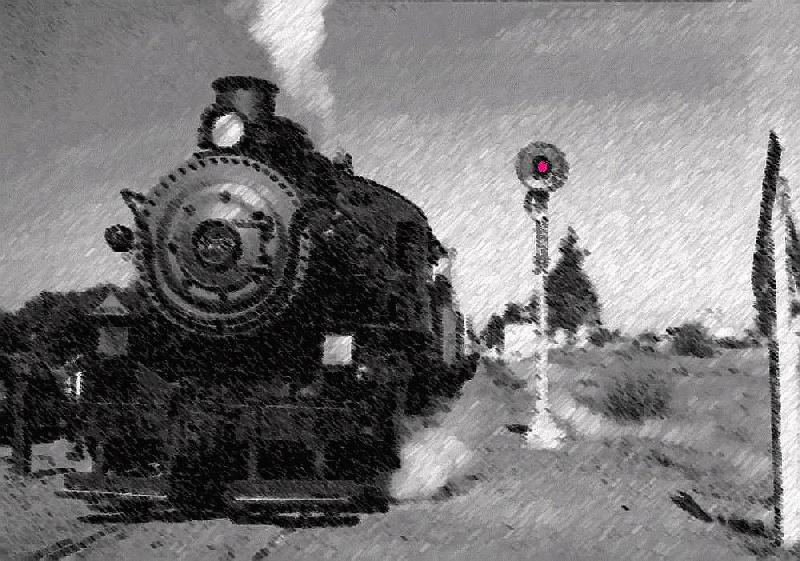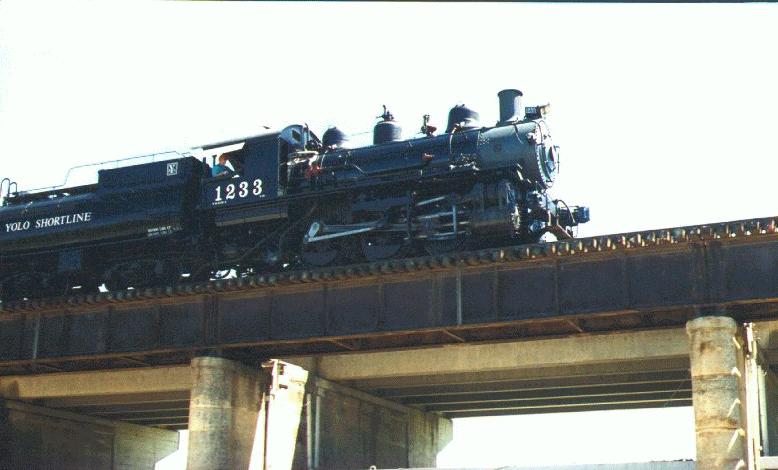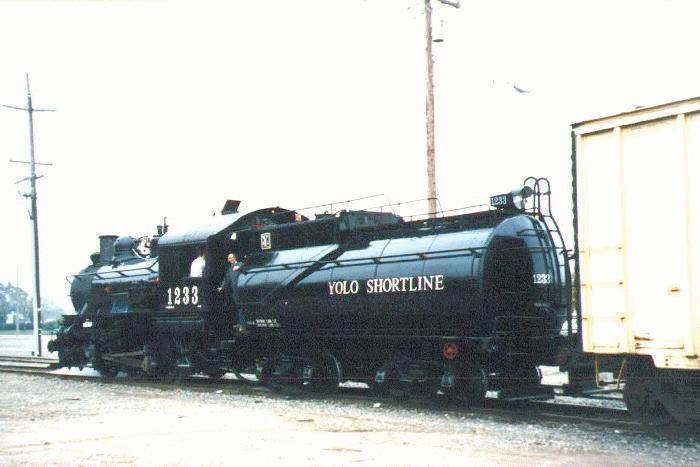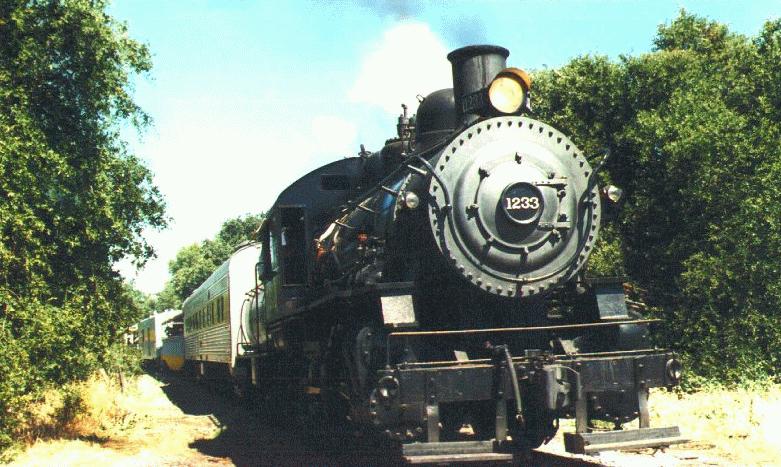
Steam locomotive 1233 was built in July, 1918, by the Baldwin Locomotive
Works of Eddystone, Pennsylvania as part of an order of 15 0-6-0 switch
engines. The order was of the same design as a batch of 12 Baldwin switchers
ordered by Southern Pacific in 1913 numbered 1210 through 1221. Of
the order which included the 1233, five were ordered for the Central Pacific
and one was ordered for the Arizona Eastern. The latter was designated
by Southern Pacific as Class S-51 and the remainder were designated Class
S-10. Once delivered, they became part of the more than 450 six-wheeled
steam locomotives owned by the Southern Pacific system during the 100-plus
years that steam reigned as king on the railroads.
Weighing in at 154,600 pounds on its 51 inch drivers, the 1233 occupied 30 feet,
eight and one-quarter inches of rail and stood 13 feet, eight inches at
its highest point. Oil-fired, the 1233's boiler operated at a maximum of
175 psi and developed a tractive effort of 27,376 pounds. The locomotives
in 1233's build-order were delivered with acetylene headlamps and oil-fired
lamps in the cab. Each engine cost $35,000.
The 1233 lived an unremarkable life, switching freight cars in
the yards at Tracy and Oakland for most of its career. About six months
after it was delivered, the 1233 underwent several boiler modifications at
the Tracy shops. When it was returned to service on February 18, 1919,
the 1233 had an increased maximum boiler pressure of 190 psi and its tractive
effort had increased by 2,350 pounds.

In 1926, the entire firebox was replaced, although the reason was not
noted on the record. In 1934, the 1233 was converted (at Oakland) to operate
with electric lights. A dynamo was installed on the boiler just ahead of the
cab, the carbon tank was removed from the fireman's cab floor, and the
oil lamps in the cab and acetylene headlamp were all replaced with a 32
volt electrical system. Sometime in 1936, a new crown sheet was installed. The 1233
had its last major overhaul in October 1951, when it received new journal
brasses and tires, the boiler flues were reset, and the locomotive received
a thorough going-over.
Near the end of its service, the 1233 was used to shuttle passenger
cars through the wash rack at Oakland. In March of 1956, the 1233 was retired
from service. Alco S-2 diesel-electric locomotives had been purchased to
replace the aging steamers and the 1233 joined many of its sisters in
the dead line at Oakland. Its date with the scrapper's torch was apparently
sealed when it was vacated from the company roster on July 24, 1956.
At about the same time, the Woodland Chamber of Commerce was looking
for a steam locomotive to display at the fairgrounds. In the mid-1950's,
the glut of dead-lined steam locomotives had caused the price of steel and
iron to drop to nearly nothing. Railroads, rather than hold the locomotives
and wait for the market to improve, wanted to move the locomotives off
their property as soon as possible. Like many other railroads, Southern Pacific offered
steam locomotives to cities for display. And Woodland, like many other
cities, wanted a steam locomotive, but not a big one...just a small reminder
of the steam era.
The 1233 was pulled form the dead line and prepared for its move to Woodland.
The tender retired behind the 1233, a Class 52-C-1, was apparently deemed
unfit to make the journey, so the tender was recovered from another locomotive.
In a photo provided by rail photographer Stan Kistler, the 1233 sits in
Oakland on September 9, 1956, with a fresh coat of paint and the replacement tender,
a class 70-C-10. This tender was apparently also not road-worthy, as it
was replaced prior to the trip with tender #6970, another Class 70-C-10.
In an ironic twist, the 6970 was retired behind the 1234!

Final arrangements were made and the 1233 moved in a train from
Oakland to Woodland near the end of December, 1956. Interestingly enough,
when the locomotive arrived in Davis, it was deemed to be facing the "wrong
way." According to the Woodland Daily Democrat newspaper, some debate had
ensued days earlier as to whether the 1233 should be displayed facing Highway
113 from the fairgrounds or "show its hind end to all who passed." By the
time it was decided to point the locomotive to the west, it was already
en route. So, upon arrival at Davis, the locomotive was run around the
wye which surrounds the depot there, then sent on to Woodland.
It was stored on the Adams Grain siding across the highway from the fairgrounds.
Just how the locomotive would be moved across the street was the source
of much discussion. In fact, the Chamber of Commerce sponsored a contest
to solicit ideas. Winning the $10 first prize was Paul Oxley of Woodland,
who suggested the obvious: lay track across the street and roll it into
the fairgrounds.
On Saturday, March 30, 1957, work began to move the 1233 across East
Street into the Yolo County Fairgrounds. Southern Pacific Roadmaster Frank
Pucci directed the track laying and supervised the move. A local trucking
company provided two truck tractors. An abundance of help showed up, and
the entire scene took on a carnival-like atmosphere. The move took the
entire weekend and was not without incident. Close examination of the tender
front deck and locomotive apron will reveal the scars of a hasty torch
cutting. Apparently the track curvature into the fairgrounds was sharper than the
minimum radius the 1233 could negotiate, so the offending parts had to
be temporarily removed.
Once the move was completed, small wedges were welded on the rails ahead
and behind one set of locomotive wheels. A dedication was held during the Yolo
County Fair in August of that year.
The 1233 was moved about five years later when East Street was
widened to four lanes. Track was laid and the 1233 was pushed back about
50 feet. Over the years, it suffered the indignation of serving as a jungle
gym for kids, a target for rock-toting delinquents, and a habitat for
squirrels, moss and rust. It was eventually fenced, and remained so until
June of 1982 when initial restoration work began.
Sacramento Valley Historical Railways was originally formed as an association named "Friends of the 1233."
The founders and other volunteers began the initial cosmetic restoration of the 1233 in 1982. That year, the 1233
was painted for the Yolo County Fair. After the fair, the group decided that the 1233 could be made operational
and went to work. In the succeeding years, the group incorporated as Sacramento Valley Historical Railways and
obtained title to the 1233. SVHR also acquired other railroad equipment and the Southern Pacific Depot in Woodland.
Progress on the restoration of the 1233 was made each year and in the spring of 1989 it ran for the first time
since the mid 1950's on a short piece of panel track built at the Yolo County Fairgrounds. However, it was apparent
that further restoration and a complete boiler tube job would be required before the 1233 could be operated reliably.
Also, the panel track had to be taken up for the fair, and the fairgrounds would not be a place where the 1233 could
be operated in any significant manner.
After much discussion followed by negotiations with the (then) Yolo Shortline Railroad, it was decided that the best opportunity
to operate the 1233 was to place it into excursion operations on the Yolo Shortline.
While this resulted in some departures from perfect historically accurate preservation (e.g. the 1233 was lettered for the Yolo
Shortline), the maintenance and care would be increased, and the 1233 would have a far greater public visibility.
Other Notes
The firebox on the 1233 was replaced again much later than 1936. We think that most of the firebox was replaced
in the 1951 shopping. Most of the firebox sheets are full thickness and the stays look new, except for being encrusted
with scale (probably due to lack of boiler treatment in the last days of SP steam operations). There is no wearing of
welds, stay bolt threads, peened edges, etc., inside the firebox, which would occur through the normal course of use and
firing of the boiler.
A power reverser replaced the original Johnson Bar. Federal regulations required this, we believe in the 1930's.
The current tender behind the 1233 is an ALCO tender, not Baldwin built. It started life, we think, behind SP
consolidations. It is at least the fourth tender to operate behind the 1233 (we have pictures showing three other
tenders during the 1233's working life). The 1233's original tender was a sausage type of tender. The number on the
back of the current tender, which was uncovered during repainting, was the 1267, not the 1234. Perhaps it saw service
behind both of those engines.
In January 1995, the Yolo Shortline trucked the 1233 from the fairgrounds approximately 1 mile to its yard on East Main
Street. The engine was trucked separately from the tender. It rained on
both days on which the moves occured. Temporary panel and ramp tracks were built to load the locomotive and tender onto the low bed
trailers. Each move took approximately 4-5 hours from start to finish.
The planned work on the 1233 to place it into operation did not get started until early winter of 1995-1996.
All of the 1233's new tubes were reset and
two superheater flues were replaced. The FRA inspections were made and a successful hydro test was accomplished. The
crosshead guides were re-machined and remounted and new crosshead slippers were made. The rods were put on and
a new boiler jacket was fabricated. Many other small items were attended to, such as fixing the air-pump, getting piston
rings unstuck (from carbonization) and installing the smokebox appliances. The 1233 was painted and lettered in a style
patterned after the pre-1940's SP style.
The first fire-up of the 1233 occured in April of 1996 and several test runs were made in the Woodland yards
to check new bearing and fix minor problems that arose. The first steam trip was made with a full excursion
train in May when the 1233 ran from Woodland to Clarksburg and back. Most people riding that first trip never new that
the 1233 broke its main water line to the boiler injectors that day. It happened while the 1233 and its train was awaiting
the return of its passengers from a lunch break. The crew, with few tools, managed to make a hasty fix.
While in operation, the 1233 proved capable for both freight and passenger service. The 1233 saw some freight service,
since it was "going that way anyway," so why not take the freight too? The primary operational problem was foaming in
the boiler and priming (carrying water over into the throttle and to the cylinders). This was due primarily to old
scale remaining in the boiler from SP days. Frequent boiler washes helped the problem and water treatment proved essential.
The cylinder lubricant was also changed to help alleviate the problems caused by the foaming and priming.
